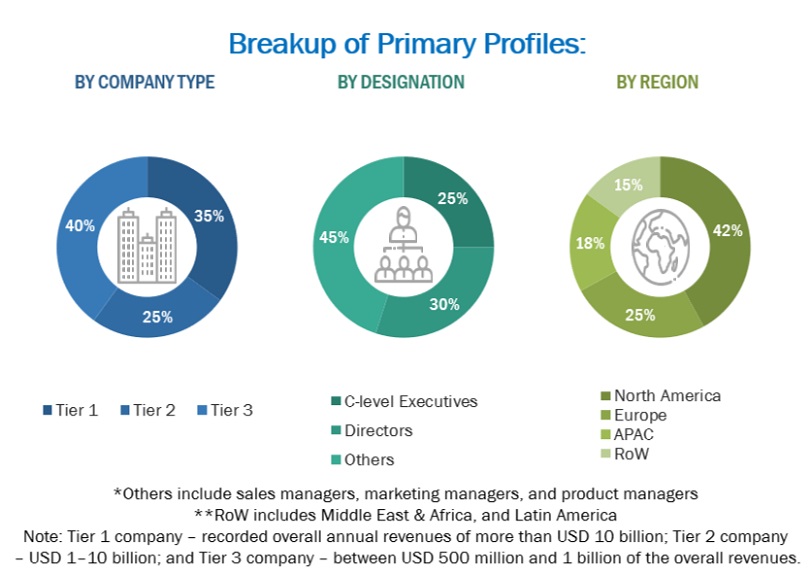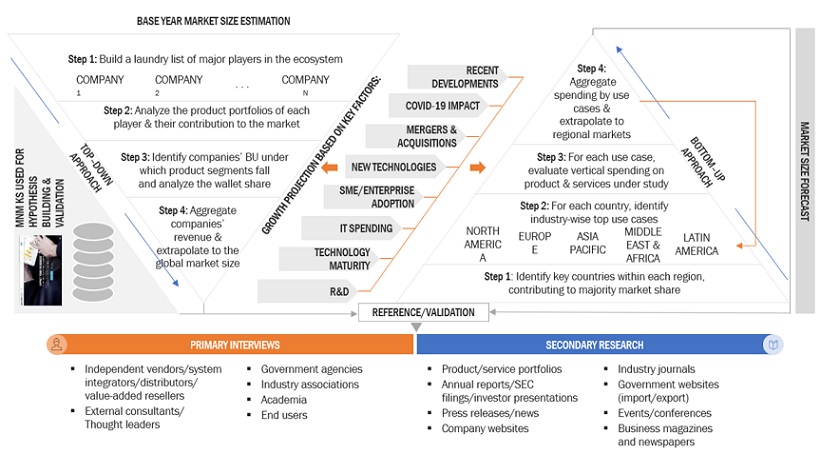This research study involved extensive secondary sources, directories, and databases, such as Bloomberg BusinessWeek, EconoTimes, and Factiva, to identify and collect information useful for this technical, market-oriented, and commercial study of the Edge Computing market. The global Edge Computing market size is obtained by evaluating its penetration among the major vendors and their components in this market. A few startups and private companies were interviewed to gain better visibility and in-depth knowledge of the market across regions. In addition, a few government associations, public sources, conferences, webinars, journals, magazines, articles, and MarketsandMarkets internal repositories were referred to arrive at the actual market size.
The primary sources were mainly the industry experts from the core and related industries and preferred system developers, service providers, system integrators, resellers, partners, standards, and certification organizations from companies and organizations related to various segments of the Edge Computing industry's value chain. In-depth interviews were conducted with various primary respondents, including key industry participants, subject matter experts, C-level executives of key market players, and industry consultants, to obtain and verify critical qualitative and quantitative information and to assess the prospects.
Secondary Research
The market size of the company component Edge Computing and services was determined based on secondary data available through paid and unpaid sources. It was also arrived at by analyzing the product portfolios of major companies and rating the companies based on their performance and quality.
In the secondary research process, various sources were referred to to identify and collect information for this study. Secondary sources included annual reports, press releases, and investor presentations of companies; white papers, journals, and certified publications; and articles from recognized authors, directories, and databases. The data was also collected from other secondary sources, such as journals, government websites, blogs, and vendors' websites. Additionally, the spending of various countries on Edge Computing was extracted from the respective sources. Secondary research was mainly used to obtain the critical information related to the industry's value chain and supply chain to identify the key players based on solutions, services, market classification, and segmentation according to components of the major players, industry trends related to components, users, and regions, and the key developments from both market- and technology-oriented perspectives.
Primary Research
In the primary research process, various sources from the supply and demand sides were interviewed to obtain qualitative and quantitative information on the market. The primary sources from the supply side included various industry experts, including Chief Experience Officers (CXOs); Vice Presidents (VPs); directors from business development, marketing, and product development/innovation teams; related key executives from Edge Computing vendors, industry associations, and independent consultants; and key opinion leaders.
Primary interviews were conducted to gather insights, such as market statistics, the latest trends disrupting the market, new use cases implemented, data on revenue collected from products and services, market breakups, market size estimations, market forecasts, and data triangulation. Primary research also helped me understand various trends related to technology, components, end users, and regions. Demand-side stakeholders, such as Chief Information Officers (CIOs), Chief Technology Officers (CTOs), Chief Security Officers (CSOs), and digital initiatives project teams, were interviewed to understand the buyer's perspective on suppliers, products, service providers, and their current use, which would affect the overall Edge Computing market.

To know about the assumptions considered for the study, download the pdf brochure
Market Size Estimation
This section of the report highlights different methods to determine the Edge Computing market size. The research method involved the use of top-down and bottom-up approaches.
The top-down and bottom-up approaches were used to estimate and validate the size of the Edge Computing market and the size of various dependent subsegments. The research methodology used to estimate the market size included the following details:
-
The key players in the market were identified through secondary research, and their revenue contributions in respective regions were determined through primary and secondary research.
-
This entire procedure included studying top market players' annual and financial reports and extensive interviews for key insights from industry leaders, such as CEOs, VPs, directors, and marketing executives.
-
All percentage splits and breakups were determined using secondary sources and verified through primary sources.
-
All possible parameters affecting the market covered in this research study were accounted for, viewed in extensive detail, verified through primary research, and analyzed to get the final quantitative and qualitative data. This data was consolidated and added with detailed input and analysis from MarketsandMarkets.
Top-down approach
The top-down approach prepared an exhaustive list of all vendors' offerings in the Edge Computing market. The revenue contribution for all vendors in the market was estimated through annual reports, press releases, funding, investor presentations, paid databases, and primary interviews. Each vendor was evaluated based on its components. The aggregate of all companies' revenues was extrapolated to reach the overall market size. Each subsegment was further studied and analyzed for its global market size and regional penetration. The markets were triangulated through both primary and secondary research. The primary procedure included obtaining critical insights from industry leaders, such as CEOs, VPs, directors, and marketing executives. The market was derived from adopting Edge Computing solutions by different verticals. The market numbers were further triangulated with the existing MarketsandMarkets repository for validation.
Bottom-up approach
In the bottom-up approach, the adoption trend of Edge Computing in major countries for regions that contribute to most of the market share was identified. The adoption trend of Edge Computing, along with different use cases concerning their business segments, was identified and extrapolated for cross-validation. Weightage was given to the use cases identified in other areas for the calculation. An exhaustive list of all vendors' component solutions and services in the Edge Computing market was prepared. The revenue contribution of all vendors in the market was estimated through annual reports, press releases, funding, investor presentations, paid databases, and primary interviews. Vendors with Edge Computing components were considered to evaluate the market size. Each vendor was evaluated based on its components across user types. The aggregate of all companies' revenue was extrapolated to reach the overall market size. Each subsegment was studied and analyzed for its market size and regional penetration.
Based on these numbers, the regional split was determined by primary and secondary sources. The procedure included an analysis of the market's regional penetration. Based on secondary research, the regional spending on Information and Communications Technology (ICT), socioeconomic analysis of each country, strategic vendor analysis of foremost Edge Computing solutions and service providers, and organic and inorganic business development activities of regional and global players were estimated. With the data triangulation procedure and data validation through primaries, this study determined and confirmed the exact values of the overall market size and its segments' market size.
Edge computing market: Top-down and Bottom-Up approaches

To know about the assumptions considered for the study, Request for Free Sample Report
Data Triangulation
The market was divided into several segments and subsegments using the previously described market size estimation procedures once the overall market size was determined. When required, market breakdown and data triangulation procedures were employed to complete the market engineering process and specify the exact figures for every market segment and subsegment. The data was triangulated by examining several variables and patterns from government entities' supply and demand sides.
Market Definition
Considering various sources and associations, MarketsandMarkets defines Edge Computing as "the practice of processing data near the source of generation, rather than relying on a centralized data processing warehouse or cloud server. This approach reduces latency and bandwidth usage by processing data closer to where it is generated, typically at the network's edge, such as on IoT devices, routers, or other connected devices. The market for edge computing encompasses hardware, software, and services aimed at enabling efficient and decentralized data processing, storage, and analysis at the network's edge. It caters to manufacturing, healthcare, transportation, telecommunications, and more industries, where real-time data processing and low-latency applications are essential".
Key Stakeholders
-
Training and consulting service providers
-
Information Technology (IT) infrastructure providers
-
Component providers
-
System Integrators (SI)
-
Support service providers
-
Cloud Service Providers (CSPs)
-
Government organizations and standardization bodies
-
Datacenter providers
-
Regional associations
-
Independent hardware and software vendors
-
Value-added resellers and distributors
Report Objectives
-
To define, describe, and forecast the Edge computing market basis component (hardware, software, services), application, organization size, vertical, and region
-
To offer comprehensive details regarding the primary variables impacting the market's growth (drivers, restraints, opportunities, and challenges)
-
To determine the high-growth market sectors to assess the opportunities for stakeholders in the market
-
To forecast the market size for five major regions—North America, Europe, Asia Pacific, the Middle East & Africa, and Latin America
-
To analyze the subsegments of the market concerning individual growth trends, prospects, and contributions to the overall market
-
To create a thorough analysis of the market's major players' profiles, market share, and fundamental skills
-
To track and analyze competitive developments in the global Edge computing market, such as product enhancements, product launches, acquisitions, partnerships, and collaborations.
Available Customizations
With the given market data, MarketsandMarkets offers customizations per the company's specific needs. The following customization options are available for the report:
Product Analysis
-
The product matrix provides a detailed comparison of each company's product portfolio.
Geographic Analysis
-
Further breakup of the Asia Pacific market into countries contributing 75% to the regional market size
-
Further breakup of the North American market into countries contributing 75% to the regional market size
-
Further breakup of the Latin American market into countries contributing 75% to the regional market size
-
Further breakup of the Middle Eastern & African market into countries contributing 75% to the regional market size
-
Further breakup of the European market into countries contributing 75% to the regional market size
Company Information
-
Detailed analysis and profiling of additional market players (up to 5)



Growth opportunities and latent adjacency in Edge Computing Market